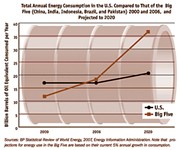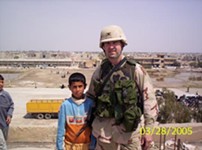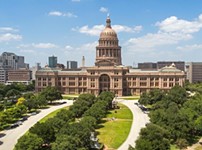Lethal Weapon
FBI's Use of Tear Gas Questioned at Davidian Trial
By Robert Bryce, Fri., July 7, 2000

It was likely the biggest tear gas assault ever seen in America. It was undoubtedly the deadliest. It began when it was still dark. Clive Doyle, one of just nine Branch Davidians who made it out of the burning ruins of Mount Carmel, testified last week about sleeping inside the chapel section of the building. "I could hear tanks all night," said Doyle, who woke at about 4am on the morning of April 19, 1993, to study the Bible. "Any time the tanks came close, the building shook," he recalled from the witness stand in the Davidians' civil suit against the federal government. He also remembered the FBI broadcasting to them over the loudspeakers, warning that they were going to use tear gas. "They said the gas would contaminate our food and clothes and we might as well come out," Doyle said. The first dose of tear gas was shot into Mount Carmel at about 6am by a 60-ton Patton tank fitted with a huge boom and outfitted with spray canisters containing a quart of tear gas each. During that first assault, the tank inserted six canisters -- roughly a gallon and a half -- of the gas. "I saw people in the chapel who had short sleeves on trying to rub it off; they were crying," Doyle testified. "It was like battery acid on your skin."
After the first tank assault came the ferret rounds. FBI agents, riding inside M2 Bradley Fighting Vehicles, began shooting 40mm ferret rounds containing CS tear gas into every available window at Mount Carmel. (CS gas gets its name from the two American scientists who invented it -- B.B. Corson and R.W. Stoughton.) The agents used Army-issue grenade launchers to fire the projectiles, each of which contained 3.7 grams of CS gas dissolved in 33 grams of the solvent methylene chloride. Over the next six hours, the FBI shot about 400 ferret rounds at Mount Carmel. About 375 of them made it inside. The second assault came at 7:30am. More ferret rounds were shot inside the building while the tanks shot in six more canisters filled with tear gas. Doyle recalled the panic inside as men, women, and children tried to find refuge from the gas. "There were no masks for the children," recalled Doyle.
Another assault came at 9am with the tanks inserting another four bottles of CS. By that time, the levels of tear gas inside the building were reaching extremely high levels. A 1995 report prepared by Failure Analysis Associates for the National Rifle Association estimated that when the third assault ended, CS concentrations inside the building ranged from "30 to 90 times that required to deter trained soldiers." The report also found that levels of methylene chloride, a compound similar to chloroform, were reaching levels nearly two times those considered "immediately dangerous to life and health" -- IDLH, a common measure of toxicity for chemical compounds.
By the time of the fourth assault at 11:45, when a tank inserted another four canisters of tear gas, the FBI had run out of ferret rounds and began looking for more. According to the Failure Analysis report, in the minutes before the first fire was spotted at Mount Carmel at 12:07pm, CS concentrations ranged from five to 60 times the level needed to deter soldiers. Methylene chloride levels still exceeded IDLH standards. By the time the fire started, the Failure Analysis report estimates that the FBI had inserted about seven gallons of tear gas weighing more than 77 pounds. For comparison, the average canister of Mace, a common brand name for self-defense tear gas, contains about 2.5 ounces of CS.
Of all the actions taken by the FBI at Mount Carmel in their efforts to get David Koresh and the other Davidians to surrender, the use of the tear gas may be the most controversial. For years, the Davidians and their supporters have alleged that the CS gas was either a cause or a contributor to the raging fire that devoured the building shortly after noon that day. And given the history of CS and the prohibitions against its use during war, the Branch Davidians' attorneys were eager to present expert testimony on the potential toxicity and flammability of CS in their $675 million civil suit against the federal government.
But last week, U.S. District Judge Walter Smith prevented any discussion in his courtroom about the dangers of CS. Smith ruled that the FBI's decision to use the gas, and in such a massive amount, was covered by what is called the "discretionary function" exception. He agreed with Dept. of Justice attorneys that federal employees are exempt from liability for certain actions because they are exercising their discretion. In documents filed with the court, government attorneys insist that "judgment calls" by the FBI "concerning how best to enforce criminal laws are not subject to second-guessing via a tort action." By excluding testimony on the CS gas, Smith appears to have short-circuited one of the four stated areas of inquiry of the civil trial. Before the trial began, Smith ruled that it would focus on four issues: whether federal agents used excessive force during the Feb. 28, 1993 raid; whether they sought to demolish Mount Carmel on April 19, 1993; whether they were negligent in suppressing the fire; and finally, whether they contributed to the fire.
The last issue is perhaps the most important. Federal authorities have always contended that Koresh and the Davidians set themselves aflame and that all the blame for the fiasco in Waco rests on them, not the government. But Eric R. Larsen, a Ph.D. chemist who has studied fire suppression and inhalable anesthestics for three decades, says there's plenty of evidence to suggest that the CS gas contributed to the fire. Larsen, who was in the courtroom last week but was not allowed to take the witness stand, says that methylene chloride, the dispersing agent used with the CS gas, was deadly by itself. Larsen, who volunteered to testify for the Davidians at no charge, submitted a sworn statement to the court that was not seen by the five members of the jury. In it, he says that CS dust would "pose the risk of a flash fire," and also that methylene chloride is a "very potent, fast-acting inhalation general anesthesia agent -- nearly on par with Halothane, the most potent agent currently used in surgical anesthesia."
There were many variables that may have limited the effectiveness of the tear gas at Mount Carmel. High winds may have blown some of the gas out. Some of the insiders, like Doyle, used a gas mask. Others may have found areas where the gas effects were limited. But Larsen, who holds 47 U.S. patents on chemical processes, told the court that using even the lowest estimates for tear gas concentrations inside Mount Carmel, "many of the deaths of occupants, particularly of the children, were caused directly or indirectly by the effects" of the methylene chloride.
Twenty-five children died at Mount Carmel; 18 of them were 10 years old or younger. In an interview with the Chronicle, Larsen said the FBI simply didn't follow federal safety guidelines when it decided to use the CS mixed with methylene chloride. And he blames it on the FBI's lack of familiarity with chemical weapons. The FBI "understands guns," he said. "They don't understand an equal opportunity killer like gas that turns corners and permeates things and kills or injures anyone it comes in contact with."
The Power of CS
Invented in 1928, CS is called a "super tear gas" because it works instantaneously, causing burning eyes, coughing, breathing difficulty, stinging skin, and vomiting. CS -- the common name for orthochlorbenzalmalononitrile -- is a fine white powder, about the consistency of talcum powder, and it must be spread with some type of dispersing agent. But it has several nasty qualities, including its flammability. When burned, CS releases a deadly gas, hydrogen cyanide. And when methylene chloride -- the dispersing agent of choice -- is burned, it releases deadly hydrogen chloride and chlorine. Both chemicals, in turn, release large amounts of carbon monoxide. According to the Failure Analysis report, 44 of the 76 bodies recovered from Mount Carmel tested positive for cyanide. And according to the coroner's report, a quarter of the deaths at Mount Carmel were caused by carbon monoxide asphyxiation, while another 27% died of smoke inhalation.
Despite its potential drawbacks, CS had many of the advantages that the Army wanted. And in 1959, it adopted CS as its standard riot-control agent. But the Army has long been aware of its potential deadliness, particularly when used in enclosed spaces. One 1985 Army manual warns that CS "is not to be used in buildings, near hospitals, or in areas where lingering contamination could cause problems." In 1995, the Los Angeles Times quoted a spokesman for Federal Laboratories Inc., a company that makes CS gas, who explained that CS is designed for use in a large, open area. "If you were to shoot too much in a building or enclosed area, you could suffocate individuals," the spokesperson said.
The politics of CS were an ongoing irritant to the American military in Vietnam. In February of 1968, Gen. William Westmoreland, who commanded American troops in Vietnam, asked Washington for the authority to use CS during search and rescue missions in Laos. But diplomats in Washington were worried. Several stories had run in The New York Times that were critical of American use of "non-lethal gas" in Vietnam. And diplomats were worried because the Geneva Protocol of 1925 prohibited the use of "asphyxiating, poisonous, or other gases" during wartime. In a 1971 memo to President Richard Nixon, Secretary of Defense Melvin Laird discussed the implications of using CS gas during operations in North Vietnam and Cambodia. The State Department, he wrote, had "reservations" that were based on "anticipated charges of 'gas warfare'..."
Despite Laird's fears, CS gas became a favorite weapon of the American military in Vietnam. It was delivered in grenades against the Viet Cong in their underground tunnels. It was dropped from helicopters and airplanes in either powdered form or in small bomblets that dispersed the agent over a wide area. Some estimates put the amount of CS used during the Vietnam War at 15 million pounds.
After Vietnam, CS became popular among other militaries. Saddam Hussein's troops used it during Iraq's war against Iran. A few years later, after American troops routed Hussein's army, the UN Special Commission found that nearly half of Iraq's loaded chemical munitions contained not nerve agents or mustard gas, but CS. The compound was also used in the fighting in what was formerly Yugoslavia. In 1988, Amnesty International reported that medical personnel in Israel had cited tear gas as "the cause of or a contributory factor in the deaths of more than 40 Palestinians in the Occupied Territories." The report caused American manufacturers of CS to halt exports of the gas to Israel.
On Jan. 13, 1993, the United States and dozens of other countries signed the Chemical Weapons Convention, the most far-reaching treaty regarding prohibitions on the use of chemical weapons. The treaty bans the use of nerve agents, mustard gas, and other compounds, including tear gas, during wartime.
Three months and six days after the U.S. signed the convention, the FBI used CS on the Branch Davidians. ![]()
Got something to say on the subject? Send a letter to the editor.








